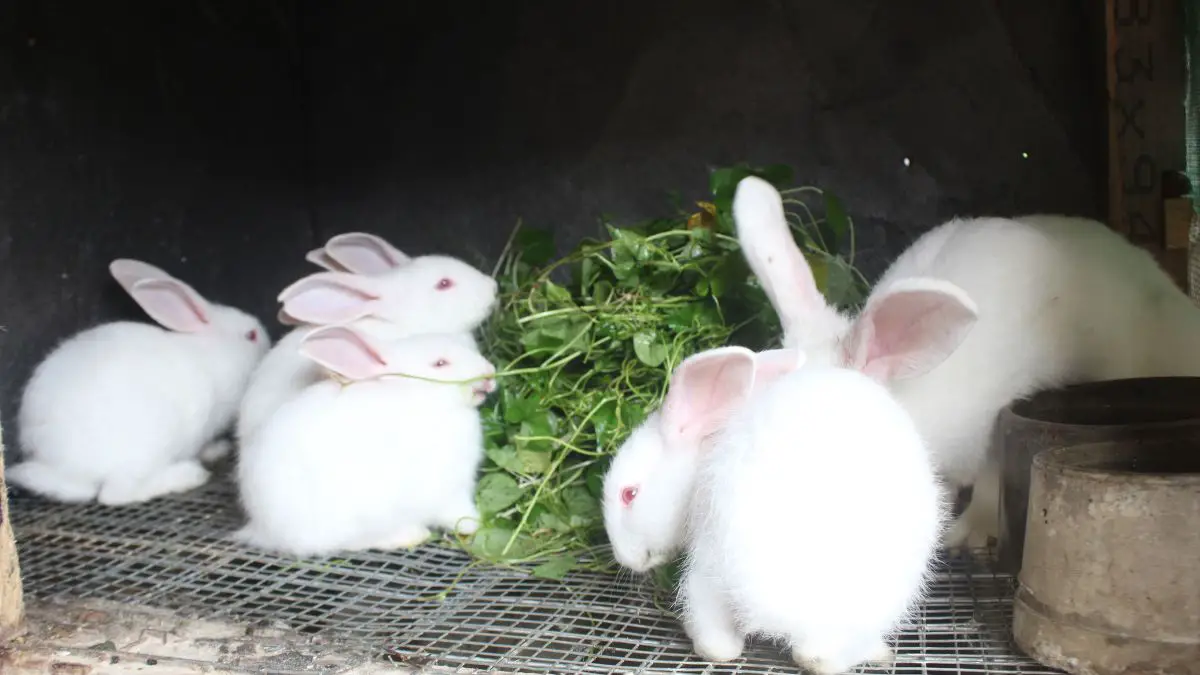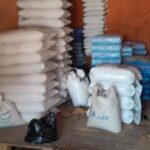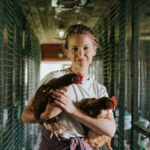Some links on this page may contain affiliate links which means that, if you choose to make a purchase using the link, Agricfy.com may earn a small commission at no extra cost to you. For more information, go to our Affiliate Disclosure Page!
Introduction
Do you know with little money and a small space in your backyard you can start a rabbit farm?
Do you know with just a few thousand you can start rabbit production?
Rabbit production is an important practice that provides a source of income and food for consumption.
It is a rare business that is very profitable. Rabbit meat is very nutritious, it contains a high protein quantity, the capital required to start rabbit production is minimal and the agricultural practice is called Cuniculture.
Cuniculture is an agricultural practice of breeding and rearing rabbits for their meat, Fur, and skin purposes. Rabbit Farming is a very profitable business that requires little capital to start up and maintain.
It has no religious prohibitions or cultural taboos like dogs and pigs. It can be consumed by all religions and ethics.
How To Make Money From Rabbit Farming
Rabbit can be raised for its:
- Meat: It serves as food or a source of income for the farmer.
- Skin: the skin is valuable, it has an international market Worth millions although it is not yet popular in the market. The skin can be used in Making clothes, blankets, etc.
- Fur: It is also called rabbit hair, it can be used in the making of hats, coats, sweaters, and knitting yarns, etc
Types of Rabbit Breeds To Make Money

- New Zealand: The New Zealand breed is a popular breed raised for meat and fur production. It originated in the USA and the Czech Republic. It has four color varieties such as white, red, black, and broken. It is the first American rabbit breed, the crossing of Belgian hare and Flemish giant produces a New Zealand breed, its first litter was in 1917, it has a commercial body type that is well rounded and muscular, its head is round and its ears are thick.
- California: It is also known as California white, it is bred as a meat and fur-producing rabbit in the early 1920s in the USA. It is also an excellent house pet, it has an all-white coat with dark markings on the nose, feet, ears, and tail.
- Chinchilla: It originated in France. There are two species which are Chilean chinchilla and Chinchilla chinchilla and four variations of chinchilla which are: standard, American, Gigantes, and Giant chinchilla. They are differentiated by their sizes because they have the same fur type and color, they were identified by the American Rabbit Breeders Association in 1930 though it is originated in France in 1919. It is very fast, is known for the color of the coat, and is easily recognized through the fur.
- Tadla: It originated from Morocco and it can be easily identified with its unique Agoutin color, it was bred in 1994 to serve as meat.
- Balad: It is primarily reared for its meat, it is a docile animal, it originated from Egypt and it varies in color which includes white, black, and red. Balad rabbits come in three coats of color: red or white, these rabbits approximately 2.7kg(6lb) and a typical litter consists of 5-6 kits. their head is convex, their eyes are black, their ears are erect, their feet and legs are medium in length and their tails are short and straight.
- Lilac: They are medium-sized with mature buck, it is bred for their meat and fur production, it is originated from England and their color is lavender(purple). The lilac is a mid-sized rabbit, hardy, slow maturing, and docile. At maturity, a male rabbit weighs from 5.5 to 7.5 pounds (2.5 to 3.4kg) while the female Lilac 6 to 8 pounds ( 2.7 to 3.6 kg). They are known to be good mothers, litter sizes are small averaging 4 to 6 kits.
- Flemish Giant: It is raised for its meat and fur, and originated from Belgium. It has different colors which are white, black, and steel. The Flemish giant is the largest breed of domestic rabbit (Oryctolagus Cuniculus Domesticus). They are historically a utility breed used for fur and meat. They are often kept as pets as they are known for being docile and patient when being handled.
Different Systems of Rabbit Production
- Extensive: This system of production consists of rabbits less than 20 and they feed mainly on forages and leftover foods.
Extensive rearing of rabbits doesn’t require much financial commitment as it doesn’t go beyond rearing in a small area mostly at home and feeding will also cost less.
Various methods of raising rabbits with pasture as the primary food source have been developed. Pasturing of rabbits can be done within a fence or in a cage, getting them fed with grass, roughage, leftover foods, and so on. Extensive rearing is mainly for meat or pets.
2. Semi-intensive: The rabbit raised using this system can be greater than 50 and can be up to 100. They are fed forages with concentrates.
3. Intensive: In this type of production, rabbits raised are greater than 200 and they are fed mostly concentrates. An intensive system of production is more focused, efficient, and time-sensitive, utilizing a greater density of animals and higher turnover.
The labor required to produce each harvested hide, a kilogram of wool, or market fryer and the quality thereof is higher than for extensive methods. Feeding rabbits in this method could be expensive and pasture might not be effective.
Although pellet feed could be nutritious and enhance growth. It could be a great source of income for rabbit farmers.
Important Management Operations of Rabbit Farming
i. Feeding: Nutrition is an important aspect of rabbit production. Proper nutrition has a great effect on rabbit growth, reproduction, and health.
Ordinarily, more than 75% of the investment in rabbit farms is spent on nutrition alone. Common food sources in rabbit nutrition are fodder plants which are mainly fiber sources and ultimately provide energy.
Other sources of energy are fruits, tuber crops, grains, etc. Sources of proteins are leguminous forages, seed meals, and processed grains (BDG). Minerals are supplied by the supplied fodder plants and salts and vitamin premixes in formulated feeds.
Formulated feed commonly called concentrates are diet formulated to supply the rabbit with a balanced ration. They are made up of grains, seed meals, oil, and premixes.
ii. Mating: It is the introduction of a sexually matured male rabbit (buck) to a sexually matured female rabbit (doe) for the purpose of copulation so that the doe will get pregnant to produce young rabbits (kits).
Rabbits become sexually mature at about 4 months but they should be bred at 6 months of age. The farmer determines the rate of reproduction because the rabbit is an induced ovulatory. The reproduction rate may vary from as few as 3 liters per year to as many as 10 liters depending on the production system. Animals to be mated should be healthy, in good physical condition, and of the appropriate weight.
Mating should be carried out at the cool hours of the day.
iii. Pregnancy Management: Pregnancy is mostly detected through palpation of the abdomen within 10 – 14 days of mating. Palpation after 14 days may lead to abortion if the doe is pregnant and it is not effective if performed earlier. The empty doe should be mated or inseminated immediately after confirmation. Pregnant rabbits should be well-fed with adequate nutrition and closely monitored throughout the period of gestation.
The gestation length in the rabbit is between 28 and 33 days.
iv. Kindling Supervision: The normal gestation length in rabbits is between 28 to 33 days the average being 30 days. Pregnant doe(s) would normally pull hairs from its abdomen for 14 days to kindling in order to make a nest for her kits.
Hence, a doe should be provided with a kindling box where it would make a nest 7 – 5 days before kindling. Kindling is usually an easy operation and does not require the presence of the farmer. If the doe does not kindle inside the box, the kits could be moved into the nest as soon as possible. Dead kits and focal sacs that are not eaten by the animals should be removed from the cage or nest.
v. Weaning: It is the separation of the young rabbits from the mother to permanently stop breastfeeding. The age range of the kits is between 1 month and 2 months and depends on the production system and the intended market live weight. When kits are separated from their mother and give up milk as a source of nutrition.
Depending on the production system, it usually takes place within a month or two after kindling when the kit should normally weigh more than 500 grams. It is advisable to remove the doe from the young weaners to reduce post-weaning stress.
vi. Fostering: This is when the kits of a doe are given to another doe to nurse (breastfeed). It becomes necessary when a doe is unable to nurse or dies during parturition. It is also carried out when a doe has a very large litter.
Fostering should take place within 3 days of kindling and the age of the fostered litter and their siblings should not be more than 48 hours.
vii. Sexing: This is done to determine the gender of the young rabbits. It could be done as early as a week after kindling or at weaning. It is important when stocking.
viii. Stocking Density: This is an important management practice to track the growth of the animals and the efficient utilization of feed.
ix. Weighing: This is an important management practice to track the growth of the animals and the efficient utilization of feed. Calibrated scales are the tool of choice.
x. Culling: It is the removal of sick, deformed, or underperforming animals from the stock.
xi. Vaccination: It is the introduction of a killed or weakened disease-causing organism into the body of the animal to engender immunity against the disease caused by the organism.
It is important to vaccinate against diseases in endemic areas.
xii. Deworming: It is the application of insecticide to control internal parasites in the animal. Internal parasites compete with the animal on the available nutrients derived from the feed supplied to the animals and cause malnourishment and loss of form.
Piperazine and sulfaquinoxaline are examples of drugs used to treat endoparasites.
Common Diseases Of a Rabbit
| Disease | Cause/Causal organism | Symptom | Control/treatment | |
| 1 | Coccidiosis | Protozoa (Eimera spp.) | Lack of appetite, bloody faeces, et | Good hygiene, antibiotics. |
| 2 | Pneumonia | Bacteria, mycoplasma | Difficult breathing, coughing, nasal discharge | Antibiotics, Protection from cold and wind. |
| 3 | Mange | Mite | Itching, skin lesions, alopecia | Insecticide, avoidance of overcrowding |
| 4 | Fur block | Lack of sufficient fibre | Loss of appetite and weight, rough fur | Feed dry forage, supply more fibre |
| 5 | Pasteurellosis | Bacteria | Nasal discharge, inflammation of the air passage | Good hygiene and antibiotics |
| 6 | Metritis | Bacteria | White sticky discharge from the vulva | Cull infected animals and disinfect cages |
| 7 | Worm infestation | Tapeworms, pinworms, etc, | Worm in faeces, loss of weight, etc |
How To Start A Rabbit Farm: Setting Up A Rabbit Farm
The following are factors to be considered in establishing a rabbit farm:
- Site selection: An appropriate site should be chosen for the location of the farm. Legislation, accessibility, proximity to the market, security, and availability of adequate water sources and space are important factors to consider in doing this.
- Foundation stock: Animals with good characteristics depending on the purpose of the farm must be chosen to establish the farm. The following characteristics should be considered:
i. Animals that have a large litter and good mothering abilities, e.g. New Zealand White and the Californian.
ii. Animals that adapt easily to the environment, e.g. NZW. Offspring from a composite population of rabbits is also recommended.
iii. Animals with rapid growth especially during the first 3 months of life (crosses of NZW and Californian can grow from a 45gram day-old kit to 1.6kg 3 months later).
iv. Healthy physically fit animals. v. Animals from a known pedigree.
- Housing: Good housing is central to rabbit welfare and productivity. The housing of the rabbit should provide adequate protection from theft, predators, and adverse weather conditions.
It should be comfortable for the animals, and the handlers and easy to clean and maintain.
Some features of rabbit housing are:
i. Adequate ventilation
ii. Adequate natural illumination.
iii. Rain and windproof
iv. Durable and weather resistant
v. Self-cleaning
vi. Availability of quarantine and storage area.
Domestic rabbits can be raised outdoors or indoors. Housing for rabbits ranges from outdoor hutches to indoor cages, to the free run of the home. Whichever option is most suitable for your home and rabbit, all should provide shelter from extreme weather conditions and predators as well as a resting retreat.
Outdoor rabbits should be housed in hutches made of wood, metal or wire cages. Hutches can be quite expensive.
The wire cage, although not as good in terms of protecting and providing comfort for your rabbit, is a cheaper option. Most rabbit owners prefer wooden hutches as metal ones tend to become quite hot in summer.
Rabbits are susceptible to heat stress and as they do not sweat or pant, the only way they cool down is through their ear veins, which is often not sufficient in the heat of the summer sun. Therefore, it is important that the hutch or cage is sheltered under a verandah or a shady tree.
A hutch should be divided into two connecting areas – one area with a wire mesh door to allow light and air through, and also to prevent bugs such as mosquitoes from biting your rabbit.
The other area should provide weather protection against the sun, cold, wind, or rain. Most hutches or some cages will have a hinged door at the top to allow easy access for cleaning. The floor of the hutch or cage should be covered with newspaper and then laid with hay to provide cushioning and warmth for your rabbit.
A solid board or rug can be put in cages to avoid your rabbit’s feet being caught in the wire. The hutch or cage should be raised off the ground and secured from cats, dogs, and predators in your surroundings.
The size of the hutch or cage depends on the size of your rabbit (fully grown), the number of rabbits you intend to keep in the housing, and how much time they spend in it.
The larger the house the better it is for your rabbits. The hutch or cage must also have a place for food and plenty of water.
Rabbits can be litter trained so put a litter tray lined with newspaper and hay in the hutch or cage and clean it out daily.
- Cages: Cages are an important part of rabbit housing. They can be kept outside a building as it is obtained in most backyard systems or within the rabbit pen in most commercial production.
Sometimes rabbits are kept in a deep litter system without cages. Cages can be made of concrete, wood, metal wire, and bamboo.
When constructing cages for rabbits, accessibility, comfort for the animal and easy waste removal must be considered. The general dimensions of cages for rabbits are given below;
| Length (cm) | Width (cm) | Height (cm) | |
| Buck | 40 – 46 | C | 30 – 44 |
| Doe (with inner nest box) | 65 – 70 | 50 – 61 | 30 – 44 |
| Doe (with outer box) | 50 – 60 | 50 | 30 |
| 76 – 76.5 | 60 – 61 | 43 – 44 |
Important Equipment in The Rabbit House
Just like every other type of farming, when you want to start a rabbit farm, there is some equipment that you need to have on your farm no matter how small or big your proposed farm is.
- Bucket
- Shovel
- Table
- Chair
- Bench
- Knife
- Medical equipment
- Lamp.
The equipment mentioned above may look basic but they are mostly overlooked by farmers in running a successful rabbit farm. They are like the daily driver of the farm aside from the rabbits and their feeds.
Rabbits could be a source of protein-rich, high-quality meat. It also requires little space to rear. Unlike cow rearing, with a little space, you can set up a rabbit farm with a low financial commitment.
Rearing rabbits could be interesting and as well as less stressful. One can rear domestically as a pet or in a big pen for commercial purposes. Why not give it a try today?







